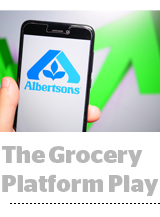 The US retail chain Albertsons, which also operates grocery brands like Safeway, Acme and Shaw’s, is accelerating investments in the data-driven advertising platform it launched last year for consumer brands carried in stores.
The US retail chain Albertsons, which also operates grocery brands like Safeway, Acme and Shaw’s, is accelerating investments in the data-driven advertising platform it launched last year for consumer brands carried in stores.
The idea is to turn its retail loyalty card programs into an advertising and attribution engine, since those shoppers can be tracked over time or retargeted online by advertising technology. Albertsons works with Quotient as its platform tech provider.
And now that its loyalty data can be effectively monetized, Albertsons is doing more to drive sign-ups. Some Albertsons grocer brands introduced loyalty cards in the past year or two, and now the loyalty programs account for 20-30% of purchases, Sales said. Safeway, which has had a membership club program for decades, is between 80-90%.
The first year of the ad platform program focused on test campaigns to evaluate the connection between its ad campaigns and store sales, said Karen Sales, Albertsons’ VP of national shopper marketing. But with a year under its belt, Albertson’s is ramping up its capabilities.
For instance, Albertson’s can now identify households that have consistent buying behavior over the course of a year, which creates stronger test controls or lookalike audiences, Sales said. Or if basket sizes increase for those shoppers, Albertson’s can demonstrate incremental growth for CPG brands.
Pepsi, one of the first brands to test Albertsons’ ad platform, is hunting for data that can prove incremental return on ad spend (ROAS). “That’s the metric we look for and believe in as a company,” said Stacey Nachtaler, the CPG giant’s director of shopper marketing.
What enables the ROAS metric is matching and tracking an individual over time, she said. Pepsi can’t do that alone because it doesn’t know who buys its product, only how much and where it sells. Google or Facebook could match and track known users, but those platforms restrict campaign measurement, so Pepsi can’t do its own ROAS modeling like it does with Albertsons and Quotient.
Nachtaler said those local campaigns with Albertsons had strong ROAS, and Pepsi is planning more campaigns where it targets specific offers to an audience category, like music fans or young families, that’s geo-fenced within 5 miles of a grocery store.
General Mills has a similar desire to figure out what drives in-store sales. Over the past two years, the food manufacturer has aggressively tested digital and retail ad platforms, said Ed Madden, the brand’s sales director. It’s even using Ahalogy, an influencer marketing startup Quotient acquired last year, to connect social posts with in-store promotional drives.
CPGs still tend to use retail platforms tactically, as opposed to always-on marketing channels like search and social. But Albertsons is turning more weeks-long campaigns into consistent ad platform business, Sales said.
With Quotient’s daily campaign reports, the retailer can do in-flight optimization and start to construct models for CPGs, like if a campaign is working well with discount hunters or organic foodies.
“If you’re timely with results it means you can get into a targeting and optimization program,” she said. “That gets you back into a planning cycle where you’re already building the next campaign.”
This post was syndicated from Ad Exchanger.


More Stories
Ibotta Crosses The IPO Finish Line – Now The Real Work Begins
Commerce Can No Longer Be Where Creative Goes to Die
Is This TikTok Ban, Like, Happening?; DTC Darlings Lose Their Retail Darling